Upright spin
The upright spin is one of the three basic figure skating spin positions. It is defined as a spin position with an extended skating leg which is not a camel position.[1] Two popular variations of the upright spin are the layback spin and Biellmann spin.
| Figure skating element | |
|---|---|
| Element name: | Upright spin |
| Scoring abbreviation: | USp |
| Element type: | Spin |
Variations
There are many variations on the upright spin.
- A basic two-foot spin is an upright spin in which the skater rotates with both feet on the ice.[2]
- A basic one-foot spin is an upright spin in which the skater rotates with one foot on the ice. Spins can be skated on either of the feet.[3][4]
- A scratch spin is an upright spin with the free leg crossed in front of the skating leg. The arms and free leg begin in an open position, extended straight out and high. They are pulled in gradually, which accelerates the spin, and the leg is pushed down so that the feet are crossed at the ankles. This spin is performed on a very tight backward inside edge.[3][4]
- A back scratch is similar to the forward scratch spin, only performed on the opposite foot and on a tight backward outside edge. This is usually learned soon after the scratch spin is mastered, and is the basic air position for jumping.[4]
- A crossfoot spin is a back upright spin in which the free leg is crossed behind the skating foot, or the front foot on a back upright is lowered and the spin becomes a two-footed spin.[2]
- A layback spin is an upright spin in which the back is arched and head dropped back. A variation of this spin is the catch foot layback or haircutter, in which the skater grabs the free blade and pulls it toward their head while in the layback position.[3][5]
- An attitude spin is a variation in which skater turns her head and looks to the side, instead of arching and looking up, while the free leg is held in attitude position as for a layback spin. The leg position is the feature of this variation.[3][5]
- A Biellmann spin is a variation of the layback spin and performed by pulling the free leg from behind up and over the head. The blade of the skate may be held with either one or both hands.[3][6]
- "I" spins, or upright front-grab spins, are a variations in which the skater pulls the free leg up in front of the body towards the face in a vertical split, creating an I position with the leg and the torso.
- A shotgun spin is a variation of the upright front-grab spins in which the free leg is held in a horizontal position.
- "Y" spins are variation in which a skater pulls the free leg up into a vertical split towards the side of the body, creating a Y shape with the leg and the torso. The support can be from either or both arms, and the hold can either be on the skate or the ankle.
Photo gallery of upright spins
In single skating

Scratch spin
(Guan Jinlin)
Corkscrew or crossover spin
(Amber Corwin)
Layback spin
(Angela Nikodinov)
Catch foot layback spin
(Jelena Glebova)
Haircutter spin
(Angela Maxwell)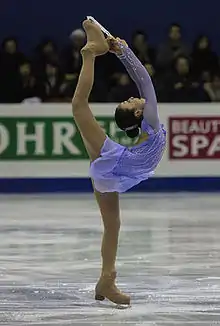
Biellmann spin
(Mao Asada)
I spin - ankle hold
(Sasha Cohen)
I spin - skate hold
(Alina Zagitova)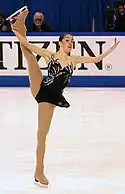
Y spin - ankle hold
(Alissa Czisny)
Y spin - skate hold
(Shawn Sawyer)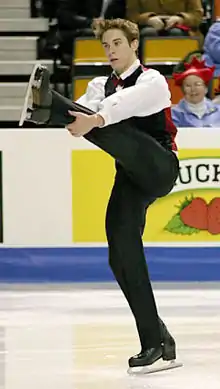
Shotgun spin
(Tristan Thode)
An "A" spin
(Jeffrey Buttle)
An upright spin variation
(Carolina Kostner)
An upright spin variation
(John Hamer)
In pair skating and ice dance
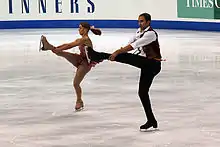
Side by side shotgun spins
(Tiffany Vise & Derek Trent)
Dance upright spin
(Shae-Lynn Bourne & Viktor Kraatz)
Dance upright spin
(Isabelle Delobel & Olivier Schoenfelder)
Dance upright and catchfoot spin
(Isabelle Delobel & Olivier Schoenfelder)
Dance upright and Biellmann spin
(Jana Khokhlova & Sergei Novitski)
Dance upright and Y-spin
(Tanith Belbin & Benjamin Agosto)
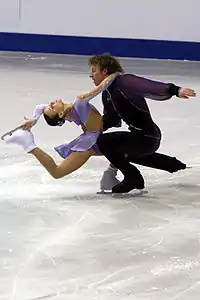
References
Citations
- "ISU Communication No. 1445". Archived from the original on 2007-10-22. Retrieved 2015-01-09.
- Petkevich, John Misha (1989), Figure Skating: Championship Techniques, Sports Illustrated, ISBN 1-56800-070-7
- "Kay" K. J. N. (2001), Figure Skating Journal Glossary, Spins, retrieved 2007-05-10
- Korte, Don (2004-02-25), Figure Skater's Website - Recognizing the Spins - Upright Spins, retrieved 2007-05-10
- Korte, Don (2004-02-25), Figure Skater's Website - Recognizing the Spins - Layback and Attitude Spins, retrieved 2007-05-10
- Korte, Don (2004-02-25), Figure Skater's Website - Recognizing the Spins - Biellmann Spins, retrieved 2007-05-10
| Wikimedia Commons has media related to Upright spins. |
This article is issued from Wikipedia. The text is licensed under Creative Commons - Attribution - Sharealike. Additional terms may apply for the media files.